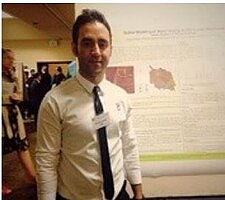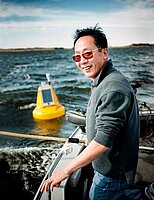Assessment and monitoring Devils Lake water quantity and quality using hydrological/water quality models and Remote Sensing.

Afshin Shabani is a Ph.D. student in Earth System Science and Policy program at the University of North Dakota. He holds a Master of Science degree in Remote Sensing and Geographic Information System form the university of Tehran, Iran, and Bachelor degree in watershed engineering, Gonbad Kavos university, Iran. He is interested in environmental studies and his present research is focused on modeling and monitoring Devils Lake water quantity and quality.
Email: Afshin.Shabani@und.edu
Phone: 701-335-3129
Fellow: Afshin Shabani
Advisor: Xiaodong Zhang, Ph.D, Professor, Department of Earth System Science and Policy, North Dakota University.
Assessment and monitoring Devils Lake water quantity and quality using hydrological/water quality models and Remote Sensing.
Devils Lake (DL) has a long history of water level fluctuation. Over the last two decades, the lake level has increased nearly 10 m, flooding the surrounding communities and infrastructure. Over one billion USD has been spent on mitigation measures, including upper basin water management to reduce the runoff, continuing infrastructure protection and developing emergency outlets. Releasing water from Devils Lake to the Sheyenne River through emergency outlets is controversial because the lake water contains a significantly higher concentration of dissolved solids, particularly sulfate. To study Devils Lake water levels fluctuation and sulfate concentrations we have coupled SWAT and CE-QUAL-W2 models. We also study the impact of the outlets on the Sheyenne River floodplain and water quality by coupling SWAT and HEC-RAS models. To monitor the Devils Lake water quality, we have deployed a buoy in the lake which measures the water temperature, chlorophyll concentration, total suspended solids, etc. In addition, we have carried out three field measurements in cooperation with North Dakota Department of Health to measure the chlorophyll concentration and total suspended solids in different parts of the lake at the time of Landsat satellite pass. We are applying our buoy and field measurements to retrieve water temperature, chlorophyll concentration, and total suspended solids from the Landsat images.
Project Objectives:
To achieve the goal, we propose to address the following specific objectives:
- Simulation of Devils Lake water levels fluctuation and sulfate concentrations
- Simulation of the Sheyenne River streamflow and floodplain
- Evaluate impact of the Devils Lake emergency outlets on the Sheyenne River floodplain and sulfate concentrations
- Retrieving Devils Lake water quality parameters such as water temperature, chlorophyll, and total suspended solids from the Landsat images.
Progress:
We have successfully coupled SWAT and CE-QUAL-W2 models to simulate the Devils Lake water levels and sulfate concentration. The coupled model performed well in simulating daily flow in tributaries and reproduced the lake water level with a root mean square error of 0.35 m for the study period from 1995 to 2016. The sulfate concentration simulated by the coupled model for the lake is in general agreement with the field observations. The model results show that the operation of the two outlets since August 2005 has lowered the lake level by 0.94 m, while raised sulfate concentration in the Sheyenne River from ~100 to > 500 mg l-1. However, the coupled SWAT and CE-QUAL-W2 models simulation shows increasing sulfate concentration of Devils Lake from west to east, which makes the operation of the east outlet more of a concern for degrading the water quality in the Sheyenne River. SWAT model also was successfully used to simulate daily streamflow for the Sheyenne River. Simulated streamflow in the Sheyenne River showed that the maximum impact of outlets operation on the river discharge is limited to two years flood < 40 m3 s-1. The HEC-RAS model was able to use daily SWAT streamflow output and simulate the Sheyenne River floodplain. The results of the coupled SWAT and HEC-RAS models showed that operating outlets double the Sheyenne River floodplain, however, the extended floodplain is within confines of two years flood and has shallow flood depth < 0.2 m.
Fourteen cloud-free Landsat images have been downloaded for the Devils Lake for the time period from 2013 to 2016. The images are preprocessed by applying atmospheric correction and calculating water leaving reflectance. The lake water temperature is calculated using Split window algorithm. The calculated water temperature showed R2= 0.92 and RMSE < 1.3° C agreement with situ water temperature measured by a buoy in Devils Lake.
Significance:
The rising water level in Devils Lake has raised concerns regarding both water quantity and quality. To the best of our knowledge impacts of the Devils Lake water levels fluctuations on the lake sulfate concentrations and the Sheyenne River water quantity and quality have never been studied before. The results of this study will aid in water management and decision making to mitigate Devils Lake flooding and the impact on downstream rivers by accounting for both quantity and quality of waters.
Peer-Reviewed Journal Papers:
Shabani, A., Zhang, X. and Ell, M. 2017. Modeling Water Quantity and Sulfate Concentration in the Devils Lake Watershed Using Coupled SWAT and CE-QUAL-W2. Journal of American Water Resources Assessment. 53 (4), 748-760.
Conference/Seminar Presentations:
Shabani, A., Zhang X., 2017. Estimate Water Surface Temperature from the Landsat 8 TIR bands using the Split Window Algorithm. Great Plains/Rocky Mountains Division of American Association of Geographers conference, Grand Forks, North Dakota (Oral presentation).
Shabani, A., Zhang X., 2017. Evaluating Capability of Devils Lake Emergency Outlets in Lowering Lake Water Levels While Controlling Flooding Damage to Downstream. American Geophysical Union conference, New Orleans, Louisiana (Oral presentation).
Shabani, A., Zhang X., Ell, M. 2016. Modeling Water Quantity and Sulfate Concentration in Devils Lake Watershed Using Coupled SWAT and CE-QUAL-W2. American Geophysical Union conference, San Francisco (Oral presentation).
Shabani, A., Zhang, X., and El, M. 2015. Modeling Water Quantity and Quality in the Devils Lake Watershed Using SWAT. SWAT conference, Purdue University (Oral presentation).

Xiaodong Zhang
Earth System Science & Policy
Office: Clifford Hall, Room 300
4149 Campus Road - Stop 9011
Grand Forks, ND 58202-9011
Telephone: 701-777-2490
Email: xiaodong.zhang2@UND.edu


